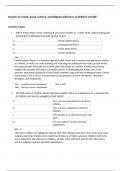-
1. Exam (elaborations) - Ch 1. contemporary perinatal and pediatric nursing in canada
-
2. Exam (elaborations) - Chapter 08 infertility, contraception, and abortion
-
3. Exam (elaborations) - Chapter 07 reproductive health
-
4. Exam (elaborations) - Chapter 6 health assessment
-
5. Exam (elaborations) - Chapter 05 health promotion
-
6. Exam (elaborations) - Chapter 04 perinatal nursing in canada
-
7. Exam (elaborations) - Chapter 03 community care
-
8. Exam (elaborations) - Chapter 23 transition to parenthood
-
9. Exam (elaborations) - Chapter 24 postpartum complications
-
10. Exam (elaborations) - Chapter 25 physiological adaptations of the newborn
-
11. Exam (elaborations) - Chapter 26 nursing care of the newborn and family
-
12. Exam (elaborations) - Chapter 27 newborn nutrition and feeding
-
13. Exam (elaborations) - Chapter 19 fetal health surveillance during labour
-
14. Exam (elaborations) - Chapter 20 labour and birth at risk
-
15. Exam (elaborations) - Chapter 51 endocrine dysfunction
-
16. Exam (elaborations) - Chapter 48 hematological or immunological dysfunction
-
17. Exam (elaborations) - Chapter 49 genitourinary dysfunction
-
18. Exam (elaborations) - Chapter 50 cerebral dysfunction
-
19. Exam (elaborations) - Chapter 54. neuromuscular or muscular dysfunction
-
20. Exam (elaborations) - Chapter 53 musculoskeletal or articular dysfunction
-
21. Exam (elaborations) - Chapter 02 the family and culture
-
22. Exam (elaborations) - Chapter 18 pain management during labour
-
23. Exam (elaborations) - Chapter 17 nursing care of the family during labour and birth
-
24. Exam (elaborations) - Chapter 16 labour and birth processes
-
25. Exam (elaborations) - Chapter 15 pregnancy at risk, pre-existing conditions
-
26. Exam (elaborations) - Chapter 14 pregnancy at risk, gestational conditions
-
27. Exam (elaborations) - Chapter 13 pregnancy risk factors and assessment
-
28. Exam (elaborations) - Chapter 12 maternal and fetal nutrition
-
29. Exam (elaborations) - Chapter 11 nursing care during pregnancy
-
30. Exam (elaborations) - Chapter 10 anatomy and physiology of pregnancy
-
31. Exam (elaborations) - Chapter 09 preconception, genetics, conception, and fetal development
-
32. Exam (elaborations) - Chapter 22 nursing care of the family during the postpartum period
-
33. Exam (elaborations) - Chapter 21 maternal physiological changes
-
34. Exam (elaborations) - Chapter 37 the preschooler and family
-
35. Exam (elaborations) - Chapter 28 infants with gestational age–related problems
-
36. Exam (elaborations) - Chapter 29 the newborn at risk, acquired and congenital problems
-
37. Exam (elaborations) - Chapter 30 pediatric nursing in canada
-
38. Exam (elaborations) - Chapter 31 family, social, cultural, and religious influences on children’s health
-
39. Exam (elaborations) - Chapter 32 developmental influences on child health promotion
-
40. Exam (elaborations) - Chapter 33 communication, history, physical, and developmental assessment
-
41. Exam (elaborations) - Chapter 34 pain assessment and management
-
42. Exam (elaborations) - Chapter 35 the infant and family
-
43. Exam (elaborations) - Chapter 36 the toddler and family
-
44. Exam (elaborations) - Chapter 47 cardiovascular dysfunction
-
45. Exam (elaborations) - Chapter 38 the school-age child and family
-
46. Exam (elaborations) - Chapter 39 the adolescent and family
-
47. Exam (elaborations) - Chapter 40 chronic illness, complex conditions, and end-of-life care
-
48. Exam (elaborations) - Chapter 41 cognitive and sensory impairment
-
49. Exam (elaborations) - Chapter 42 family-centred home care
-
50. Exam (elaborations) - Chapter 43 reaction to illness and hospitalization
-
51. Exam (elaborations) - Chapter 44 pediatric variations of nursing interventions
-
52. Exam (elaborations) - Chapter 45 respiratory dysfunction
-
53. Exam (elaborations) - Chapter 46 gastrointestinal dysfunction
-
54. Exam (elaborations) - Chapter 52 integumentary dysfunction perry, maternal child care nursing in canada
-
Show more




